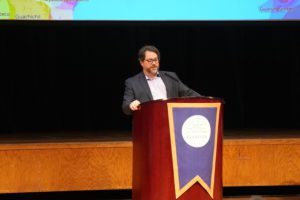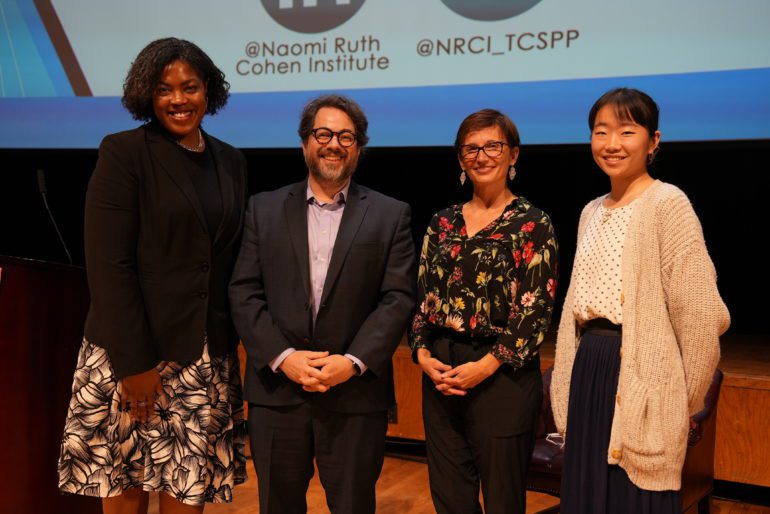On Saturday, June 12, 2022, the Naomi Ruth Cohen Institute for Mental Health Education (NRCI) convened its 20th annual conference at Evanston Township High School. The theme of this year’s gathering was “It’s Tough Enough: Adolescent Mental Health in Our Changing World.”
The event’s opening panel was moderated by Keeshawna Brooks, Ph.D., assistant professor and associate department chair of the School Psychology Department at The Chicago School. Following a spiritual message by James Holzhauer-Chuckas of St. Athanasius Parish, there was a panel that included Jonathan B. Singer, Ph.D., professor of social work at Loyola University Chicago, Taya Kinzie, Ed.D., assistant superintendent and principal at Evanston Township High School, and author and management consultant Emily Her.
Fighting mental health stigma for 20 years

Larry Cohen, founder of the Naomi Ruth Cohen Institute for Mental Health Education, opened the conference with a look back at the first conference held in 2002.
Devasted by their daughter Naomi’s death by suicide, Larry and Marilyn Cohen had planned a private service, until their rabbi offered this advice: “If you keep the service private, no one will understand why she died.”
That observation inspired the Cohens to use the tragic loss of Naomi to educate the public and spare other families a similar pain. The first conference was held in April 2002. That same year the surgeon general released a landmark report that said, “stigma was the foremost barrier to treatment.” The report marked a turning point in the recognition of the broader effects of mental health.
A teen health crisis
Twenty years later, a new advisory issued by the surgeon general highlighted an urgent need to address the nation’s adolescent mental health crisis. According to U.S. Surgeon General Dr. Vivek Murthy, “Mental health challenges in children, adolescents, and young adults are real and widespread. Even before the pandemic, an alarming number of young people struggled with feelings of helplessness, depression, and thoughts of suicide—and rates have increased over the past decade.”
In her introduction of the panelists, Dr. Brooks set the tone for the discussion by reminding everyone in attendance “to center the conversation around adolescent mental health.”
The panel’s first speaker was Dr. Singer, who began his presentation with a slide depicting the northern Midwest of the U.S. overlaid with the names of the Native American tribes that once inhabited the area. While this may have seemed like an interesting digression, Dr. Singer was quick to point out the relevance of his material. “When it comes to youth suicide,” he said, “understanding the historical legacy of genocide and the oppression of indigenous people in the U.S. is important”
One death to suicide is too many
As a “suicidologist,” Dr. Singer cited many statistics, but he reminded attendees that “behind every data point is a tear.” The picture that the data reveal in yearly trends and within each month, is as striking as it is essential in seeking methods for reducing the number of self-inflicted deaths. Since 2007, there has been a steady increase in teen suicide from 6.5 per 100,000 to 10.5, according to the Centers for Disease Control and Prevention. There are many possible reasons for this increase, including the Great Recession and the rise in social media use.
However, a key tendency that has held steady year after year is that the rate of teen suicide correlates closely with the school year. Deaths are higher during the months students are in school than in months when they are on vacation. For example, teen suicides spike in January after a seasonal low in December. This trend suggests the pivotal role teachers and school counselors play in partnering with parents to maintain student well-being.
Advice that can save a life
What leads children to self-harm or suicide is difficult to discern; however, Dr. Singer offered advice for students, parents, and educators that has made a difference with at-risk teens.
For parents, he stressed the importance of ensuring that teens get enough sleep and making sure the lines of communication remain open. While teens are often reluctant to open up to their parents, modeling behavior that supports positive mental health allows adults to speak through their actions. Dr. Singer also suggests parents “keep calm and get a pet.”
For teachers, school counselors, or administrators, Dr. Singer’s advice began with a call to “aspire to zero suicides,” because one life lost to suicide is one too many. His recommendations also included conducting universal screenings, collaborating with parents and communities, and training staff to recognize and respond to suicide risks.
For teenagers, Dr. Singer’s advice is more personal and poignant, telling teens not to worry about upsetting adults. He asks them to consider that their reasons for living might not have happened to you yet. Finally, he says to teens, “Don’t discount your experiences: some are windows; some are mirrors.”
Guiding a school district through a pandemic
The second panelist, Dr. Kinzie, described the efforts of her staff at Evanston Township High School (ETHS), to maintain the mental health of their students during remote learning. With an enrollment of more than 3,500 students, ETHS is one of the largest high schools in the country. Known for its high standards and diverse student body, the challenge of keeping students on track through the pandemic was great.

“We teamed with a variety of folks from teachers to staff to leaders and administrators to complete 205 home visits during the pandemic,” Dr. Kinzie said. “We identified students who were very disengaged and were having a really hard time re-engaging, even by attending class.”
In addition to in-person visits, the staff made more than 18,600 intervention phone calls to students during the pandemic. When in-person learning was about to resume, staff logged 1,000 phone calls to encourage disengaged students to check back in.
“What we know is student need is still great. And in order for us to adequately serve students, we have to support our staff,” Dr. Kinzie said. “As we think about what are the many ways that we’re trying to support mental health for the ETHS community as a whole.”
Make it a life worth living
The third speaker on the panel was Emily Her, a consultant and recent graduate of the University of Chicago. Raised in the Bay Area by Taiwanese immigrant parents, she said, “Many people from my community know me as a trophy child—high school valedictorian [with] prestigious awards and scholarships. I was the kid that all the other kids hated because their parents were probably comparing them to me at the dinner table.” What her peers and their parents did not know was that Her was hospitalized for anxiety and depression at the age of 11 after a third suicide attempt.

Her said she felt alone growing up. “I had no one to talk to. Mental health really was just a two-hour educational video we saw in our seventh-grade biology class,” she said. Hardest of all, she says her parents were not sympathetic. “I grew up in a household that always told me I was weak, that I was a coward, that I was never enough.”
Through therapy, Her came to understand that her family’s reaction to her illness was due, in part, to intergenerational trauma. Also known as trans- or multi-generational trauma, intergenerational trauma is passed down to subsequent generations who do not know how to cope with or process it.
Although Her was able to reach out for help, her struggles with mental illness were not over. Throughout college, she continued to suffer from anxiety, depression, and an eating disorder, which caused her to miss long periods of school. Nevertheless, she was able to graduate early and begin work as a consultant.
When Her graduated high school, she wrote the phrase “Make it a life worth living” on the back of her cap. “At the time, I didn’t know how often this phrase would save me, because every day I ask myself, ‘Have I made it a life worth living?’”
Her closed her presentation by saying, “I hope that you do as well, not just for yourself, but for the future generations to come.”
The work continues
After being canceled in 2020 and held remotely in 2021, this year’s NRCI conference was again held in person. Coordinated by NRCI Executive Director Tracy Levine, the conference also featured 18 breakout sessions on topics pertaining to teen mental health. Panels included: “Social Media and Mental Health,” “How to Help Teens Cope with Family Conflict and Separation,” and “It’s Real: Teens and Mental Health.”
Through its annual conference and a year-round commitment to mental health awareness and education, the NRCI remains, after over 20 years, a leading organization working to remove the stigma surrounding mental illness.
Watch the conference in its entirety in the video below.
To learn more about programs at The Chicago School, fill out the form below.

